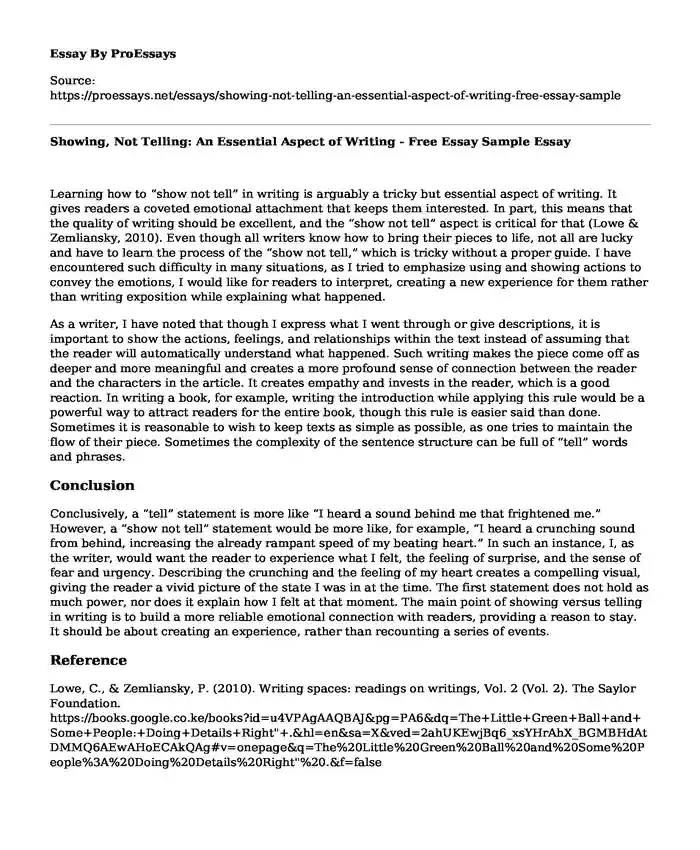Learning how to “show not tell” in writing is arguably a tricky but essential aspect of writing. It gives readers a coveted emotional attachment that keeps them interested. In part, this means that the quality of writing should be excellent, and the “show not tell” aspect is critical for that (Lowe & Zemliansky, 2010). Even though all writers know how to bring their pieces to life, not all are lucky and have to learn the process of the “show not tell,” which is tricky without a proper guide. I have encountered such difficulty in many situations, as I tried to emphasize using and showing actions to convey the emotions, I would like for readers to interpret, creating a new experience for them rather than writing exposition while explaining what happened.
As a writer, I have noted that though I express what I went through or give descriptions, it is important to show the actions, feelings, and relationships within the text instead of assuming that the reader will automatically understand what happened. Such writing makes the piece come off as deeper and more meaningful and creates a more profound sense of connection between the reader and the characters in the article. It creates empathy and invests in the reader, which is a good reaction. In writing a book, for example, writing the introduction while applying this rule would be a powerful way to attract readers for the entire book, though this rule is easier said than done. Sometimes it is reasonable to wish to keep texts as simple as possible, as one tries to maintain the flow of their piece. Sometimes the complexity of the sentence structure can be full of “tell” words and phrases.
Conclusion
Conclusively, a “tell” statement is more like “I heard a sound behind me that frightened me.” However, a “show not tell” statement would be more like, for example, “I heard a crunching sound from behind, increasing the already rampant speed of my beating heart.” In such an instance, I, as the writer, would want the reader to experience what I felt, the feeling of surprise, and the sense of fear and urgency. Describing the crunching and the feeling of my heart creates a compelling visual, giving the reader a vivid picture of the state I was in at the time. The first statement does not hold as much power, nor does it explain how I felt at that moment. The main point of showing versus telling in writing is to build a more reliable emotional connection with readers, providing a reason to stay. It should be about creating an experience, rather than recounting a series of events.
Reference
Lowe, C., & Zemliansky, P. (2010). Writing spaces: readings on writings, Vol. 2 (Vol. 2). The Saylor Foundation. https://books.google.co.ke/books?id=u4VPAgAAQBAJ&pg=PA6&dq=The+Little+Green+Ball+and+Some+People:+Doing+Details+Right"+.&hl=en&sa=X&ved=2ahUKEwjBq6_xsYHrAhX_BGMBHdAtDMMQ6AEwAHoECAkQAg#v=onepage&q=The%20Little%20Green%20Ball%20and%20Some%20People%3A%20Doing%20Details%20Right"%20.&f=false
Cite this page
Showing, Not Telling: An Essential Aspect of Writing - Free Essay Sample. (2023, Nov 03). Retrieved from https://proessays.net/essays/showing-not-telling-an-essential-aspect-of-writing-free-essay-sample
If you are the original author of this essay and no longer wish to have it published on the ProEssays website, please click below to request its removal:
- Questions on Production Design and Ecology
- The Film's Representation of the Book: The Leopard Essay
- Empathy, Narrative, and Victim Impact Statements Paper Example
- How to Be Happy Essay Example
- Essay Example on Growth Through Daily Transformation: Sources of Change
- Research Paper on Pathophysiology of Schizophrenia
- Essay Sample on The Power of Music: Enhancing Brain Development







